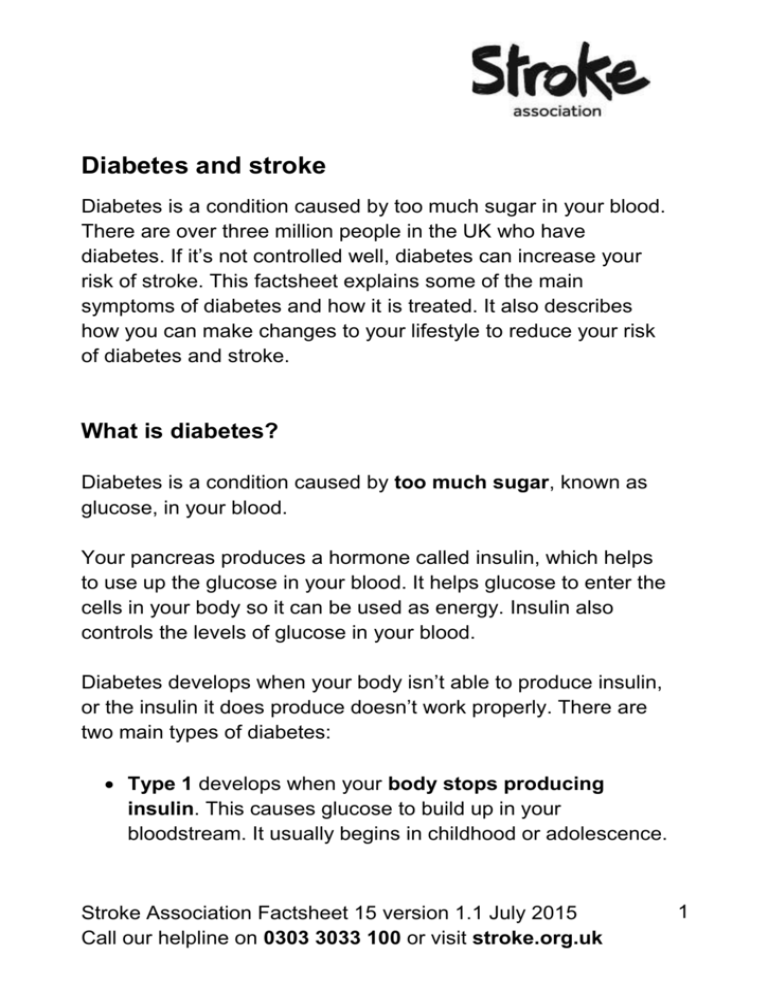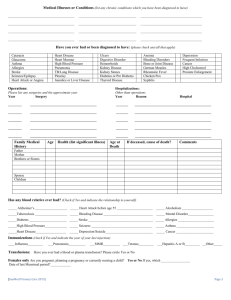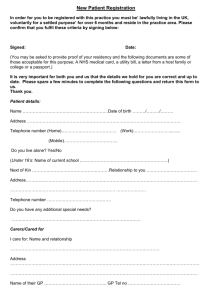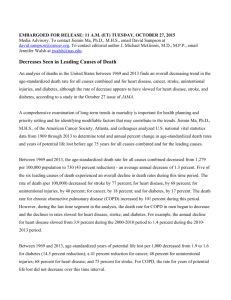Diabetes and stroke - Stroke Association
advertisement

Diabetes and stroke Diabetes is a condition caused by too much sugar in your blood. There are over three million people in the UK who have diabetes. If it’s not controlled well, diabetes can increase your risk of stroke. This factsheet explains some of the main symptoms of diabetes and how it is treated. It also describes how you can make changes to your lifestyle to reduce your risk of diabetes and stroke. What is diabetes? Diabetes is a condition caused by too much sugar, known as glucose, in your blood. Your pancreas produces a hormone called insulin, which helps to use up the glucose in your blood. It helps glucose to enter the cells in your body so it can be used as energy. Insulin also controls the levels of glucose in your blood. Diabetes develops when your body isn’t able to produce insulin, or the insulin it does produce doesn’t work properly. There are two main types of diabetes: Type 1 develops when your body stops producing insulin. This causes glucose to build up in your bloodstream. It usually begins in childhood or adolescence. Stroke Association Factsheet 15 version 1.1 July 2015 Call our helpline on 0303 3033 100 or visit stroke.org.uk 1 Type 2 diabetes develops when your body does not produce enough insulin or when your body does not react to it in the right way. This type of diabetes is much more common. Ninety percent of people with diabetes have type 2. It tends to develop gradually, usually in adulthood. It is a progressive condition, which means it gets worse over time. Some women develop another type of diabetes, known as gestational diabetes, when they are pregnant. It usually stops after your baby is born, however it can increase the risk of both you and your baby developing diabetes in the future. You’re also more likely to develop gestational diabetes if you become pregnant again. What are the symptoms of diabetes? The main symptoms of diabetes are: feeling very thirsty frequently going to the toilet to pass water – especially at night feeling very tired unexplained weight loss genital itching or regular episodes of thrush blurred vision. If you have type 2 diabetes, you may not notice these symptoms, as it tends to develop slowly over a number of years. Many people do not realise they have diabetes. It’s estimated Stroke Association Factsheet 15 version 1.1 July 2015 Call our helpline on 0303 3033 100 or visit stroke.org.uk 2 that there are 850,000 people living with undiagnosed diabetes in UK. If you are experiencing any of the symptoms we’ve listed, talk to your GP. If diabetes is not treated or controlled well, it can lead to serious health problems including loss of vision and kidney failure. What is the link between diabetes and stroke? Diabetes almost doubles your risk of having a stroke and is a contributing factor in 20% of strokes in England, Wales and Northern Ireland. This is because high levels of glucose in your blood can damage your blood vessels, making them harder and narrower and more likely to become blocked. If this happens in a blood vessel leading to your brain it could cause a stroke. Am I at risk of developing diabetes? Although anyone can develop diabetes, there are some groups of people who are at more risk than others. Some of the main risk factors for developing type 2 diabetes are: A family history of diabetes, particularly if a close relative such as a parent, brother or sister has the condition. Stroke Association Factsheet 15 version 1.1 July 2015 Call our helpline on 0303 3033 100 or visit stroke.org.uk 3 Your ethnicity. In the UK, type 2 diabetes is more common in people of South Asian, Chinese, black-African and blackCaribbean backgrounds. Being overweight or obese, especially if you carry your extra weight around your waist. Being overweight reduces your body’s ability to respond to insulin. Measuring your waist is a quick way of assessing your risk of type 2 diabetes. You are at a higher risk if your waist measures more than: 31.5 inches (80cm) for women 35 inches (89cm) for South Asian men 37 inches (94cm) for all other men. Age. If you are over 40 (or 25 if you’re South Asian) you are more likely to develop type 2 diabetes. Gestational diabetes. You are more likely to develop diabetes if you have had this whilst you were pregnant. Diagnosis and treatment Diagnosis Diabetes cannot be cured, but there are treatments that can help to keep your blood glucose levels as normal as possible. This will help control any symptoms you are experiencing and to prevent any long-term complications. Stroke Association Factsheet 15 version 1.1 July 2015 Call our helpline on 0303 3033 100 or visit stroke.org.uk 4 Diabetes is diagnosed with a special blood test. Your doctor will normally tell you what your blood glucose level is and what level it should be. If you are diagnosed with diabetes, you will work with a team of health professionals who will help you manage your condition. This team will usually include your GP, as well as a diabetes specialist nurse and a dietitian. There may be other specialists that you have to see. These could include: an eye specialist such as an ophthalmologist or optometrist to check for any damage to your eyes; a podiatrist (chiropodist) to check for any problems with your feet; or a consultant who specialises in diabetes. It’s important that you receive support and information to help you manage your diabetes well. Everyone in the UK who has diabetes should be offered a free diabetes education course. These give you the chance to learn more about your condition and how to manage it, ask questions and meet other people with diabetes. If you haven’t been offered a course, or if you think you’d benefit from a refresher, make sure you ask your GP or someone in your care team about courses that are available in your area. Diet and exercise Sometimes the early stages of type 2 diabetes can be controlled through healthy eating and regular exercise, so you may not need to take medication. Your doctor or someone else in your Stroke Association Factsheet 15 version 1.1 July 2015 Call our helpline on 0303 3033 100 or visit stroke.org.uk 5 care team should talk to you about the changes you need to make and how you can make them. Medication Sometimes diet and exercise alone aren’t enough to manage diabetes. If your blood sugar levels are high, you may need medication to help control it, but it’s still important that you eat a healthy diet and get enough exercise. There are many different types of medication available and your care team will work with you to find the best one for you. We’ve explained some of the different groups of medicines that are available below, although your tablets may have a different brand name to the ones we’ve given, depending on who manufactures them. Biguanide This type of medicine helps to lower your blood sugar levels by reducing the amount of glucose that your liver produces. It also helps your body to respond better to the insulin that it produces. There is only one type of biguanide medication, called metformin. Sulfonylureas This type of drug works by helping your pancreas to produce more insulin. It also helps your body to use insulin more efficiently. There are a number of different sulphonylureas including glibenclamide, gliclazide and glipizide. Stroke Association Factsheet 15 version 1.1 July 2015 Call our helpline on 0303 3033 100 or visit stroke.org.uk 6 Alpha glucosidase inhibitors This type of drug works by slowing down the way starchy foods are absorbed by your intestines. This means that your blood glucose levels will rise more slowly after you’ve eaten. There is only one medicine in this group, called acarbose. Prandial glucose regulators These drugs stimulate your pancreas to make more insulin. Examples include repaglinide and nateglinide. Thiazolidinediones These drugs are sometimes called glitazones. They help your body to respond more efficiently to the insulin it produces. There is only one medicine in this group, called pioglitazone. Incretin mimetics This type of medicine is given by injection. It works by increasing the amount of hormones called incretins in your body. These hormones help your body to only produce glucose when it’s needed. Examples include exenatide and liraglutide. DPP-4 inhibitors These drugs are also known as gliptins. They increase the levels of incretins in your body by blocking an enzyme called DPP-4, which destroys them. Examples include sitagliptin, vildagliptin and saxagliptin. Stroke Association Factsheet 15 version 1.1 July 2015 Call our helpline on 0303 3033 100 or visit stroke.org.uk 7 SGLT2 inhibitors This is a new type of drug. It works by reducing the amount of glucose that’s absorbed by your kidneys, so more is passed out of your body through your urine. It also helps to reduce the amount of glucose in your blood. It’s usually used with other medicines. Examples of this type of drug include dapagliflozin and canagliflozin. Insulin injections People with type 1 diabetes, and some people with type 2 diabetes, need insulin injections every day to manage their blood glucose levels. There are different types of insulin treatments available. Some are just injected once a day, others need to be injected several times a day before meals. Your care team will talk to you about the type of insulin that they think is best for you. They will also teach you how to inject yourself and help you with any concerns you may have. As with all medication, some people may experience side effects. Talk to your GP or someone in your care team if you are experiencing any side effects from your medication, as there are may be a different medicine that you could try. Stroke Association Factsheet 15 version 1.1 July 2015 Call our helpline on 0303 3033 100 or visit stroke.org.uk 8 Long-term care and support If you have diabetes it is important to have regular check-ups to make sure that you’re staying healthy and to avoid any complications. Everyone with diabetes is supposed to have a full diabetes check at least once a year. This is known as your annual diabetes review. There are nine checks that you should receive every year, to make sure that your condition is being managed well. 1. Blood glucose test Your blood glucose level needs to be checked at least once a year. An HbA1c blood test will measure your blood glucose and help you and your care team decide whether there are any changes you need to make to your diet or medication to make sure that your levels stay healthy. If you’re on insulin, you may be given a device that will help you monitor your own glucose levels at home. Someone in your care team will show you how to do this. 2. Blood pressure check When you have diabetes it’s important to keep your blood pressure as low as possible. People with diabetes should have a blood pressure of 130/80mmHg or lower. Your blood pressure can be controlled by following a healthy lifestyle, but you may also need to take medication. Someone in your care team should check your blood pressure at least once a year. Stroke Association Factsheet 15 version 1.1 July 2015 Call our helpline on 0303 3033 100 or visit stroke.org.uk 9 3. Cholesterol check Your cholesterol levels should be checked at least once a year with a simple blood test. Reducing your cholesterol levels will help to reduce your risk of stroke, as well as other conditions such as heart disease. For some people, this can be done by eating a healthy diet that is low in saturated fat. But if your cholesterol level is high, you may need to take medication to reduce it. 4. Kidney function urine test Diabetes can damage the small blood vessels in your kidneys, which can lead to kidney disease. A urine test will check for proteins in your urine, which could be a sign of kidney problems. 5. Kidney function blood test You should also have a blood test once a year to check that your kidneys are working properly. 6. Weight and BMI checks Your weight and waist measurements should be checked at least once a year. Someone in your care team should also check your body mass index (BMI). Your BMI can help you work out whether you are a healthy weight, as it compares your weight against your height. It can help you and your care team decide what weight you should be aiming for. 7. Feet check Diabetes can affect your circulation and damage the nerves in your feet. If this happens, it can be hard for small cuts or injuries on your feet to heal, which can lead to foot ulcers. Someone in Stroke Association Factsheet 15 version 1.1 July 2015 Call our helpline on 0303 3033 100 or visit stroke.org.uk 10 your care team should check your feet for poor circulation or nerve damage at least once every year. 8. Eye check Diabetes can cause an eye condition called retinopathy. Your retina is a delicate layer of tissue that lines the inside of your eye. It is sensitive to light and converts it into electrical signals that then travel to your brain. Retinopathy is when your retina becomes damaged, which can affect your eyesight. Your eyes should be checked every year. This is done using a special digital camera that can take a picture of the back of your eye (a retinal photograph). 9. Support to stop smoking If you have diabetes you are already at risk of developing heart disease and having a stroke. Smoking makes this risk even higher, so it’s essential that you stop. If you smoke or are trying to quit, someone in your care team should check how well you’re doing and make sure you’re getting all the advice and support you need to help you give up. Having diabetes diagnosed after you have had stroke Some people are only diagnosed with diabetes after they have had a stroke. For some people, diabetes may make very little difference to their day-to-day life, whereas for others it can have a big impact. You may find that you need to change your diet, take medication and monitor your blood glucose levels frequently. Coping with this as well as the effects of your stroke can be tough. It can Stroke Association Factsheet 15 version 1.1 July 2015 Call our helpline on 0303 3033 100 or visit stroke.org.uk 11 take a while to adjust to the demands of managing your condition and it‘s normal to feel overwhelmed. But just take it one step at a time. Speak to your care team about how you are feeling. Don’t be afraid to ask questions – they are there to give you the information and support you need. The organisations we’ve listed at the end of this leaflet can also provide help and support. See the Other useful contacts section for details. Need to talk? Whatever your concern is, our helpline team can help. Whether you want to know more about stroke and its effects, are looking for practical information and support or simply need someone to talk to, we’re here for you. Call us on 0303 3033 100 or email info@stroke.org.uk How can I reduce my risk of stroke? Eat a healthy, balanced diet A healthy diet is one that is low in salt, fat and sugar and includes plenty of fruit and vegetables. Your care team will be able to give you more information about the changes you need to make to your diet. Get active As well as helping to reduce your blood pressure, regular physical activity can help to control your blood glucose levels, Stroke Association Factsheet 15 version 1.1 July 2015 Call our helpline on 0303 3033 100 or visit stroke.org.uk 12 reduce cholesterol levels and maintain your overall fitness. We should all aim to do at least 30 minutes of moderate exercise five times a week. If you are taking insulin or have not exercised for some time, it’s important that you speak to your GP before starting a new activity or exercise programme. Control your weight Being overweight can raise your blood pressure and increase your risk of stroke, so it’s important to maintain a healthy weight. Talk to your GP about the weight you should be aiming for and the best way for you to lose weight if you need to. Don’t smoke Smoking doubles your risk of having a stroke. This is because it damages your artery walls and makes your blood more likely to clot. Giving up is not always easy, but there is a lot of support available to help you. Your GP or someone else in your care team can give you advice on the best way to quit or call the NHS Smokefree helpline on 0300 123 1044. Cut down on alcohol Regularly drinking large amounts of alcohol greatly increases your risk of stroke. Drinking alcohol also affects your blood sugar levels, so if you do drink, make sure you never drink on an empty stomach and stick to the recommended amounts. For men this is no more than four units per day and for women this is no more than three units per day. Talk to other people You may find that speaking to other people with diabetes is a good way of getting help and support. Diabetes UK runs local groups and care events that give you the chance to meet with other people and find out how they are coping with a similar Stroke Association Factsheet 15 version 1.1 July 2015 Call our helpline on 0303 3033 100 or visit stroke.org.uk 13 situation. Contact Diabetes UK to find out more. Go to Other useful contacts for details. How can I find out more? Talk to us Our Stroke Helpline team can give you information about stroke and tell you about the services and support that are available in your local area. Call us on 0303 3033 100 (Monday to Friday, 9am-5pm) or email info@stroke.org.uk Get online We have lots of information about stroke and how to prevent it on our website. Go to stroke.org.uk Read our publications We also produce a range of other leaflets and factsheets about stroke and related issues. You can download these for free or order a printed copy to be posted to you via our website stroke.org.uk or by calling the helpline on 0303 3033 100. Some of our other factsheets include: High blood pressure and stroke Smoking and the risk of stroke Alcohol and stroke Healthy eating and stroke Exercise and stroke. Go to stroke.org.uk for a full list. Stroke Association Factsheet 15 version 1.1 July 2015 Call our helpline on 0303 3033 100 or visit stroke.org.uk 14 Other useful contacts If you’re looking for more information, the following organisations may be able to help. All are UK wide unless otherwise stated. Please note that details of these organisations are for information only. We are not recommending or endorsing anyone by including them in this factsheet. Diabetes UK Website: www.diabetes.org.uk Diabetes Careline: 0345 123 2399 Email: careline@diabetes.org.uk Provides information and support to people living with diabetes, including details of local support groups and how to lead a healthy lifestyle. Diabetes Research and Wellness Foundation Website: www.drwf.org.uk Tel: 023 92637 808 A charity that raises awareness of diabetes and provides support to people living with the condition. How did we do? Your feedback will help us to improve our publications, making sure that they answer your questions and are easy to understand. To let us know what you think of this factsheet email us at feedback@stroke.org.uk Stroke Association Factsheet 15 version 1.1 July 2015 Call our helpline on 0303 3033 100 or visit stroke.org.uk 15 About our information We are committed to producing clear, accurate and unbiased information for stroke survivors and their families. To produce our publications we use information from professional bodies and other reliable sources including NICE, SIGN, Royal College of Physicians and medical journals. To request a list of sources used in this factsheet email feedback@stroke.org.uk © The Stroke Association 2015 Factsheet 15 version 1.1 Published July 2015. Next review July 2016. The Stroke Association is a Company Limited by Guarantee, registered in England and Wales (No 61274). Registered office: Stroke Association House, 240 City Road, London EC1V 2PR. Registered as a charity in England and Wales (211015) and in Scotland (SC037789). Also registered in Isle of Man (No 945) Jersey (NPO 369) and serving Northern Ireland. Stroke Association Factsheet 15 version 1.1 July 2015 Call our helpline on 0303 3033 100 or visit stroke.org.uk 16






